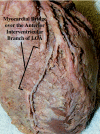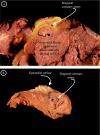The relationship of myocardial bridges to coronary artery dominance in the adult human heart
- PMID: 16822268
- PMCID: PMC2100301
- DOI: 10.1111/j.1469-7580.2006.00590.x
The relationship of myocardial bridges to coronary artery dominance in the adult human heart
Abstract
Myocardial bridging is recognized as an anatomical variation of the human coronary circulation in which an epicardial artery lies in the myocardium for part of its course. Thus, the vessel is 'bridged' by myocardium. The anterior interventricular branch of the left coronary artery has been reported as the most common site of myocardial bridges but other locations have been reported. The purpose of this study was to provide more definitive information on the vessels with myocardial bridges, the length and depth of the bridged segment, and the relationship between the presence of bridges and coronary dominance. Two hundred formalin-fixed human hearts were examined. Myocardial bridges were found in 69 (34.5%) of the hearts with a total of 81 bridges. One bridge was found in 59 of these hearts and multiple bridges were observed in ten (eight with double bridges and two with triple bridges). Bridges were most often found over the anterior interventricular artery (35 hearts). Bridges were also found over the diagonal branch of the left coronary artery (14), over the left marginal branch (five) and over the inferior interventricular branch of the left coronary artery (six). Bridges were also found over the right coronary artery (15 hearts), over the right marginal branch (four) and over the inferior interventricular branch of the right coronary artery (two). The presence of bridges appeared to be related to coronary dominance, especially in the left coronary circulation. Forty-six (66.6%) of the hearts with bridges were left dominant. Forty-two of these had bridges over the left coronary circulation and four over the right coronary circulation. Seventeen hearts (24.6%) were right dominant. Eleven of these had bridges over the right coronary circulation and six over the left coronary circulation. The remaining six hearts were co-dominant with four having bridges over the left coronary circulation and two over the right coronary circulation. The mean length of the bridges was 31 mm and the mean depth was 12 mm. The possible clinical implications of myocardial bridging may vary from protection against atherosclerosis to systolic vessel compression and resultant myocardial ischaemia.
Figures





References
-
- Angelini P, Trivellato M, Donis J, Leachman RD. Myocardial bridges: a review. Prog Cardiovasc Dis. 1983;26:75–88. - PubMed
-
- Angelini P, Villason S, Chan AV, Diez JG. Normal and anomalous coronary in humans. In: Angelini P, editor. Coronary Artery Anomalies. Philadelphia: Lippincott, Williams & Wilkins; 1999. pp. 27–150.
-
- Angelini P, Velaso JA, Flamm S. Coronary anomalies: incidence pathophysiology, and clinical relevance. Circulation. 2002;105:2449–2454. - PubMed
MeSH terms
LinkOut - more resources
Full Text Sources

